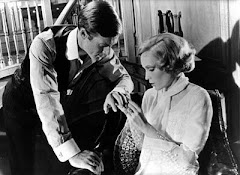
In
The Great Gatsby there are two cities separated by The Valley of Ashes, East Egg & West Egg. The author, Fitzgerald, uses these two cities to represent two classes of wealth (old wealth and new wealth). You can tell what kind of people live in what city. The people in East Egg, such as

the Buchanans, have come from families who have always had money; they have been well educated at Ivy League colleges such as Yale. Those in West Egg, on the other hand, like Gatsby, are new to great wealth. They don't come from wealthy backgrounds; rather, they have made their own fortunes. Gatsby has had family that was wealthy, but all of his family passed so that is where his money comes from. Instead of Ivy League college degrees, people in West Egg are more likely to have work experience gained while they made their money, like Nick Carraway.
Nick Carraway, a native of the Midwest, lives in West Egg, but instead of buying an extravagant house like Gatsby, he get a small cottage. Nick is more like those in East Egg because of his background, but he chooses to live in West Egg because he's trying to make it in the bond business a

nd doesn't have much money of his own. The East Egg citizens are portrayed as corrupt and mean while those in West Egg are seen are less sophisticated, and more innocent. Sadly, the residents of East Egg are consumed with material things because money has run their lives since birth. Thankfully, for those residents in West Egg, have more morals and are less absorbed in their wealth. Fitzgerald mentioned in the text that West Egg was 'less fashionable', I don't see this to be a bad thing. Like previously stated they are not wrapped up in their money, and only focusing on material things such as clothes.
Fitzgerald portrays the 1920s as an era of decayed social and moral values, evidenced in its overarching cynicism, greed, and empty pursuit of pleasure. Alas, this again results in the cash hounds that inhabit East Egg. East is more about that social standards and values, and West is more about morals. (http://www.sparknotes

.com/lit/gatsby/section3.rhtml) The West is described as the country of “wide lawns and friendly trees” (p.7,5 ), “prairies” and “lost Swede towns” (p.125,19).
East Egg represents the old aristocracy, West Egg the newly rich, the valley of ashes the moral and social decay of America, and New York City the uninhibited, amoral quest for money and pleasure. (http://www.chacha.com/question/what-are-the-major-differences-between-east-egg-and-west-egg-in-the-book-the-great-gatsby)
-It's Gatsby Baby


 926, The Great Gatsby was a silent film adaptation of the novel. Many people used this film as an example of a 'lost film'. The film had a running time of 80 minutes, or 7,296 feet, and was designed as lightweight, popular entertainment, playing up the party scenes at Gatsby's mansion and emphasizing their scandalous elements. No copies of the film are known to survive. (http://en.wikipedia.org/wiki/The_Great_Gatsby_%281926_film%29)
926, The Great Gatsby was a silent film adaptation of the novel. Many people used this film as an example of a 'lost film'. The film had a running time of 80 minutes, or 7,296 feet, and was designed as lightweight, popular entertainment, playing up the party scenes at Gatsby's mansion and emphasizing their scandalous elements. No copies of the film are known to survive. (http://en.wikipedia.org/wiki/The_Great_Gatsby_%281926_film%29)




















































